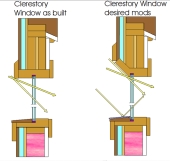Matt Todd wrote:Not sure what your overall setup is like (how the passive solar relates to the rest of the house) but I find that a 90 degree roof is ideal in my passive solar porch https://permies.com/t/173304/Solar-Porch-Passive-Solar-Retrofit
Any more admission of light would get too hot in the spring and fall. The axial tilt of the earth regulates mine simply by putting the sun higher in the sky when it's too hot out to want that direct light into the system.
I am northern Wyoming in a house built in 1984. For its time it was way over built such that it almost meets modern building insulation codes. 11% glass vs floor space on a single floor plus it has a full basement This is over the normal recommended 7%. House gets too warm in August and Sept. Intending to add a soil based AC system to counter act this eventually.(geothermal but NOT heat pump based) But the passive part of the house is not enough to stay comfortable thru the winter.(the house would never freeze even with just the passive) So 4 years ago I added an air based active collector to the front wall. I can always choose whether I bring that heat in or not. Since I added that collector I have run 2 of 4 of the last winters without heating at all. Still not totally comfortable but closer. Just finished adding an interior recirculation setup to pull more heat to the basement acting as a concrete heat battery. The goal between the collector and the interior circulation was 10 air changes per hour in the basement and both systems pull right off the floor heating as much of the basement as possible. Next step is to add another 13 feet high by 8 feet wide worth of glass collector. This will hopefully give me enough BTU's to heat the basement enough to cost thru longer runs of gray days. Currently if both active systems are running the fans for them run on 70 watts of power that is mostly only needed when the sun is shining making it ideal for PV. 4 feet of the add on collector will add to the existing collector driven by exist fans. The other 4 feet will be combined set of collectors to pull air out and push fresh air in thru and HRV core. Hopefully this much will run pure convection so no added power needed.
Next step is hot water solar primary to preheat for the water heater. The goal being to make the water heater almost not needed. During good sun this will also heat the core lines in the dirt giving the soil a preheat hopefully giving enough stored heat to provide for stored heat for the rare heat needed points to keep things comfortable. 2 pumps. One driving the collector in sun only(30 watts) And one driving the geothermal which will be run as needed for another 30 watts.
Country oriented nerd with primary interests in alternate energy in particular solar. Dabble in gardening, trees, cob, soil building and a host of others.











